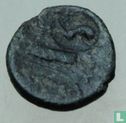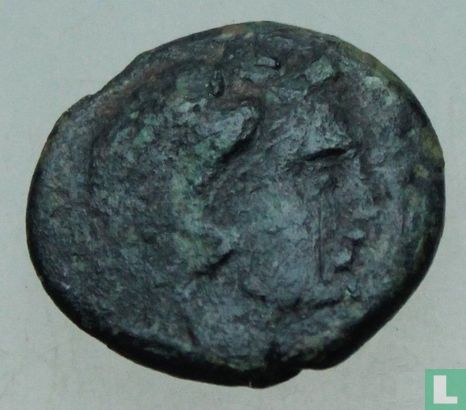

Enlarge image


Catalogue information
LastDodo number
7238767
Area
Coins
Title
Lysimacheia, Thrace AE17 309-281 BCE
Country
Face value
Year
-300
Variety / overstrike
Head of State
Type
Designer
Series
Gold- or silver content
Weight
3
Diameter
18
Thickness
Punch
Shape
Obverse
?Y???? X??? (Lysimacheia)
Reverse
Edge
Privy mark
Mint mark
Number produced
Krause and Mishler number
Catalogue number
Moushmov 5499; SNG Cop. 915; cf. Sear 1618
Details
Obv; ΛYΣΙΜΑ / XΕΩΝ along two sides of Nike standing facing,
holding wreath and palm; and with a COUNTERMARK of dolphin within circle.
Rev; Head of young Hercules right, in lion's skin.
Thrace is a historical and geographic area in southeast Europe. As a geographical concept, Thrace designates a region bounded by the Balkan Mountains on the north, Rhodope Mountains and the Aegean Sea on the south, and by the Black Sea and the Sea of Marmara on the east. The areas it comprises are southeastern Bulgaria (Northern Thrace), northeastern Greece (Western Thrace), and the European part of Turkey (Eastern Thrace). The biggest part of Thrace is part of present-day Bulgaria. In Turkey, it is also called Rumelia. The name comes from the Thracians, an ancient Indo-European people inhabiting Southeastern Europe.
The historical boundaries of Thrace have varied. Noteworthy is the fact that, at an early date, the ancient Greeks employed the term "Thrace" to refer to all of the territory which lay north of Thessaly inhabited by the Thracians, a region which "had no definite boundaries" and to which other regions (like Macedonia and even Scythia) were added. In one ancient Greek source, the very Earth is divided into "Asia, Libya, Europa and Thracia". As the knowledge of world geography of the Greeks broadened, the term came to be more restricted in its application: Thrace designated the lands bordered by the Danube on the north, by the Euxine Sea (Black Sea) on the east, by northern Macedonia in the south and by the Illyrian lands (i.e. Illyria) to the west. This largely coincided with the Thracian Odrysian kingdom, whose borders varied in time. During this time, specifically after the Macedonian conquest, the region's old border with Macedonia was shifted from the Struma River to the Mesta River. This usage lasted until the Roman conquest. Henceforth, (classical) Thrace referred only to the tract of land largely covering the same extent of space as the modern geographical region. In its early period, the Roman province of Thrace was of this extent, but after the administrative reforms of the late 3rd century, Thracia's much reduced territory became the six small provinces which constituted the Diocese of Thrace. The medieval Byzantine theme of Thrace contained only what today is Eastern Thrace.



